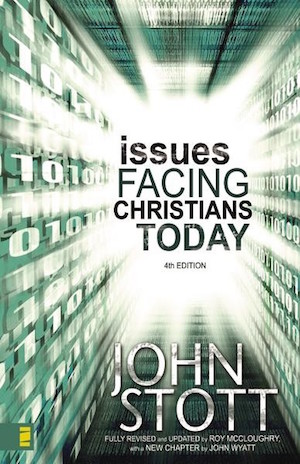 John Stott seemed broadly in favour of women’s ordination, based on his Issues facing Christians today (4th edition, 2006). He unpacks the Bible’s teaching on the equality and complementarity of men and women in a very helpful and attractive way, and then looks at what Paul says about masculine headship in 1 Corinthians 11 and Ephesians 5. This, he suggests, ‘implies some degree of leadership, which … is best expressed in terms not of “authority” but of “responsibility”’ (p. 343f).
John Stott seemed broadly in favour of women’s ordination, based on his Issues facing Christians today (4th edition, 2006). He unpacks the Bible’s teaching on the equality and complementarity of men and women in a very helpful and attractive way, and then looks at what Paul says about masculine headship in 1 Corinthians 11 and Ephesians 5. This, he suggests, ‘implies some degree of leadership, which … is best expressed in terms not of “authority” but of “responsibility”’ (p. 343f).
The husband’s headship of his wife, therefore, is a liberating mix of care and responsibility rather than control and authority. This distinction is of far-reaching importance. It takes our vision of the husband’s role away from questions of domination and decision-making into the sphere of service and nurture (p. 344).
How would this carry over into the life of the church?
There is no doubt that women are equipped by the Spirit to build up the church in all sorts of ways. But what about the commands to be silent in 1 Corinthians 14 and 1 Timothy 2? Here Stott seeks to disentangle two different requirements:
So is it possible (I ask myself) that, although the requirement of ‘submission’ is of permanent and universal validity, because grounded in creation, the requirement of ‘silence’, like that of head-covering in 1 Corinthians 11, was a first-century application of it? (p. 349)
If this is possible (as Stott tentatively suggests), then what would this ‘submission’ look like in our own context?
The basic answer he gives is that women should indeed teach, but always in the context of a team ministry in a local church (presumably not an all-female team, but that isn’t explicitly stated). But Stott would prefer to see men always serving in teams too, with their churches ‘repenting of an unbiblical one-man ministry’ (p. 350).
But what about ordination?
If God endows women with spiritual gifts (which he does), and thereby calls them to exercise their gifts for the common good (which he does), then the church must recognize God’s gifts and calling, must make appropriate spheres of service available to women, and should ‘ordain’ (that is, commission and authorize) them to exercise their God-given ministry, at least in team situations (p. 353f).
So how should people who hold this view respond to the current situation in the Church of England?
We should surely avoid the two extreme reactions. We should neither make an unprincipled surrender to cultural pressure, nor give up and secede from the church. What then? We should continue the dialogue, refusing to regard the issue as settled. Meanwhile, we should encourage ordained women to exercise their ministry voluntarily in ways which recognize masculine headship, for example in team situations (p. 351).
Two reflections.
First, if masculine headship extends beyond the marriage relationship, and if this is a good thing, then where should it be seen? Stott’s ideal, it seems, is for all leadership, in church and society, to be exercised by teams, and for all teams to consist of men and women. But if that is the case, it is hard to see what difference masculine headship makes in practice.
Second, I think more needs to be said about ordained ministry. It seems inadequate to describe it simply as being commissioned and authorised to exercise a teaching ministry (though I’m sure Stott had much more to say on the topic). After all, there are many (commissioned and authorised) forms of teaching ministry that we would not described as ‘ordained’ ministries. It seems that the roles of presbyter (priest/elder) and bishop are more specific. In fact, I would characterise them as ministries of ‘care and responsibility’, which, in Stott’s understanding, would be the very essence of headship.